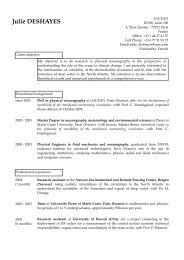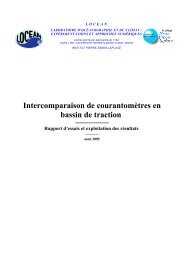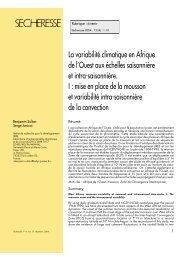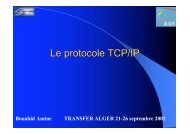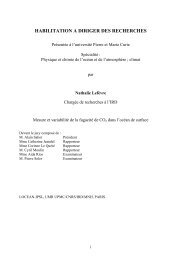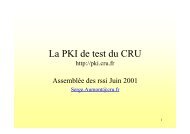PISCES biogeochemical model - NEMO
PISCES biogeochemical model - NEMO
PISCES biogeochemical model - NEMO
You also want an ePaper? Increase the reach of your titles
YUMPU automatically turns print PDFs into web optimized ePapers that Google loves.
<strong>PISCES</strong> <strong>biogeochemical</strong> <strong>model</strong><br />
Olivier AUMONT<br />
10/25/2004<br />
WARNING: This document is not intended to be an<br />
exhaustive description of <strong>PISCES</strong> and is still incomplete<br />
1 Introduction<br />
<strong>PISCES</strong> is a <strong>biogeochemical</strong> <strong>model</strong> which simulates the marine biological productivity and<br />
that describes the <strong>biogeochemical</strong> cycles of carbon and of the main nutrients (P, N, Si, Fe).<br />
Historically, this <strong>model</strong> can be seen as one of the many Monod <strong>model</strong>s by opposition to the<br />
quota <strong>model</strong>s, the other big family of ocean <strong>biogeochemical</strong> <strong>model</strong>. Thus, it assumes a constant<br />
Redfield ratio and phytoplankton growth depends on the external concentration in nutrients.<br />
This choice was dictated by the computing cost as describing the internal pools of the different<br />
elements requires many more prognostic variables. And <strong>PISCES</strong> was supposed to be suited for<br />
a wide range of spatial and temporal scales, including quasi-steady state simulations on the<br />
global scale.<br />
However, when <strong>model</strong>ling silicate, iron and/or chlorophyll, assuming constant ratios is not<br />
justified anymore as these ratios can vary a lot. For instance, the Fe/C ratio can vary by<br />
at least an order of magnitude to be compared to the N/C ratio which varies by “only” two<br />
times. Thus, in <strong>PISCES</strong>, a compromise between the two classical families of ocean <strong>model</strong><br />
was chosen. The elemental ratios of Fe, Si and Chl are prognostically predicted based on the<br />
external concentrations of the limiting nutrients like in the quota approach. On the other hand,<br />
the phytoplankton growth rates also depends on these external concentrations as in the Monod<br />
approach.<br />
Historically, the development of this <strong>model</strong> started in 1997 with the release of the P3ZD<br />
<strong>model</strong> which was a simple NPZD <strong>model</strong> with semi-labile DOM. Phytoplankton growth rate<br />
was only limited by one nutrient, basically phosphate. However, many deficiencies in this<br />
<strong>model</strong>, especially in the HNLC regions, justified the development, in 1999, of a more complex<br />
<strong>model</strong> including three limiting nutrients (Fe, Si, P), two phytoplankton and two zooplankton<br />
size-classes. This <strong>model</strong> was called HAMOCC5 (Aumont et al., 2003 ) as it was based on<br />
HAMOCC3.1 (Six and Maier-Reimer, 1996 ) and used in the LSG <strong>model</strong>. The embedding<br />
of this code in the ocean <strong>model</strong> OPA required some major changes and improvements, partly<br />
because of the much finer vertical resolution. Beside the numerical schemes, these changes were<br />
mostly an improved treatment of the optics and the splitting of the particulate organic matter<br />
into two different size-classes. All these changes and the major recodings it required lead us to<br />
adopt a new name for the <strong>model</strong>: <strong>PISCES</strong>. This name can be translated as fishes from latin.<br />
It can also be considered as an acronym, but its meaning is much less poetic and will not be<br />
1
explained here as it is not really essential.<br />
Since 2001, this <strong>model</strong> has undergone active developments. In 2004, a stable release of the<br />
<strong>model</strong> is made available to the community on the OPA website (www.lodyc.jussieu.fr/opa). It<br />
can be freely used and changed by anybody after subscription to the OPA system. Currently,<br />
this <strong>model</strong> is being coupled to OPA only. However, a beta version of the <strong>model</strong> coupled to<br />
ROMS can be obtained by sending an email to this address (aumont@lodyc.jussieu.fr). The<br />
rest of this document describes the main aspects of the <strong>model</strong>. It is still rather incomplete<br />
but it is better than nothing ... If you have any comments or suggestions, send me an email<br />
(aumont@lodyc.jussieu.fr). I do not promise to take them into account (or even to read the<br />
mail) but I’ll do my best.<br />
2 Model description<br />
<strong>PISCES</strong> has currently twenty-four compartments (see figure 1). There are five <strong>model</strong>ed<br />
limiting nutrients for phytoplankton growth: Nitrate and Ammonium, Phosphate, Silicate and<br />
Iron. It should be mentionned that phosphate and nitrate+ammonium are not really independant<br />
nutrients in <strong>PISCES</strong>. They are linked by constant Redfield ratios but the nitrogen pool<br />
undergoes nitrogen fixation and denitrification. This means that if the latter two processes are<br />
set to zero and if the sizes of the nitrogen and phosphorus pools are identical, the distributions<br />
of both nutrients should be exactly the same.<br />
Four living compartments are represented: two phytoplankton size-classes/groups corresponding<br />
to nanophytoplankton and diatoms, and two zooplankton size classes which are<br />
microzooplankton and mesozooplankton. For phytoplankton, prognostic variables are total<br />
biomass, the iron, chlorophyll and silicon contents. This means that the Fe/C, Chl/C and Si/C<br />
ratios of both phytoplankton groups are fully predicted by the <strong>model</strong>. For zooplankton, only<br />
the total biomass is <strong>model</strong>ed. For all species, the C/N/P/O2 ratios are supposed constant and<br />
are not allowed to vary. In <strong>PISCES</strong>, the Redfield ratio -O/C/N/P is set to 172/122/16/1. In<br />
addition, the Fe/C ratio of both zooplankton groups is kept constant. No silicified zooplankton<br />
is assumed. The bacterial pool is not yet explicitely <strong>model</strong>ed.<br />
There are three non-living compartments: semi-labile dissolved organic matter, small and<br />
big sinking particles. As for the living compartments, the C, N and P pools are not distinctly<br />
<strong>model</strong>ed. Thus, constant Redfield ratios are imposed for C/N/P. However, the iron, silicon and<br />
calcite pools of the particles are explicitely <strong>model</strong>ed. As a consequence, their ratios are allowed<br />
to vary. Calcite and biogenic silica are supposed to sink at the speed of the big particles. All<br />
the non-living compartments experience aggregation due to turbulence and differential settling.<br />
In addition to the ecosystem <strong>model</strong>, <strong>PISCES</strong> also simulates dissolved inorganic carbon, total<br />
alkalinity and dissolved oxygen. The latter tracer is also used to define the regions where oxic<br />
or anoxic remineralization takes place. The carbon chemistry follows the OCMIP protocols<br />
(see the OCMIP website for more information at www.ipsl.jussieu.fr/OCMIP) except that it<br />
has been simplified to reduce the computing cost. For instance, alkalinity includes only the<br />
carbonate, the borate and the water (H + , OH − ).<br />
3 Model equations<br />
The reader should be aware that in the following equations, the conversion ratios between<br />
the different elements (Refield ratios) have been often omitted except when particular parameterizations<br />
are defined. All phytoplankton and zooplankton biomasses are in carbon units<br />
2
Figure 1: Architecture of <strong>PISCES</strong>. This figure only shows the ecosystem <strong>model</strong> omitting thus<br />
oxygen and the carbonate system. The element which are explicitely <strong>model</strong>ed are indicated in<br />
the left corner of each box.<br />
except for the silicon, chlorophyll and iron content of phytoplankton. Finally, all parameters<br />
and their standard values in <strong>PISCES</strong> are listed in Table 1 at the end of this section.<br />
3.1 Equation for nanophytoplankton<br />
∂P<br />
∂t = (1 − δnano )µ nano P − m nano P<br />
K nano + P P − wnano p P 2 − g micro (P )Z − g micro (P )M (1)<br />
The production terms for nano/picophytoplankton is defined by :<br />
µ nano = µ P<br />
⎛<br />
⎝1 − e<br />
α P ( Chl<br />
C<br />
)P P AR<br />
µ P L nano<br />
lim<br />
⎞<br />
⎠ L nano<br />
lim (2)<br />
where µ P = ab cT and where the limitations terms are defined as follows:<br />
L nano<br />
po4 =<br />
L nano<br />
fe =<br />
L nano<br />
no3 =<br />
P O 4<br />
Kpo4 nano + P O 4<br />
F e<br />
K nano<br />
F e<br />
+ F e<br />
Kno3<br />
nano Knh4<br />
nano<br />
K nano<br />
nh4 NO 3<br />
+ K nano<br />
nh4<br />
NO 3 + K nano<br />
no3 NH 4<br />
3
L nano<br />
nh4 =<br />
L nano<br />
K nano<br />
no3<br />
Knh4<br />
nano<br />
lim = min(L nano<br />
po4<br />
K nano<br />
no3 NH 4<br />
+ K nano<br />
nh4<br />
, L nano<br />
F e<br />
, L nano<br />
no3<br />
NO 3 + Kno3 nano NH 4<br />
+ L nano<br />
nh4 ) (3)<br />
The choice of the half-saturation constants is rather difficult as observations show that<br />
they can very by several orders of magnitude. However, in general, these constants increase<br />
with the size of the phytoplankton cell as a consequence of a smaller surface-to-volume ratio<br />
(diffusive hytpothesis). Thus, diatoms will tend to have larger half-saturation constants than<br />
nanophytoplankton. But, in <strong>PISCES</strong>, phytoplankton is <strong>model</strong>ed by only two compartments,<br />
each of them encompassing thus a large size spectrum. Experiments performed with <strong>model</strong> have<br />
shown that results are especially sensitive to the choice of the iron half-saturation constants,<br />
and less to the other constants (with the exception perhaps of silicate). This is not surprising<br />
as over most of the ocean, the seawater iron concentrations are close to these constants.<br />
Following these remarks, it appeared not appropriate to keep the iron half-saturations constant.<br />
It was then decided to make them vary with the phytoplankton biomass of each compartment.<br />
It is assumed that they increase with biomass based on the observations showing that<br />
the increase in biomass is generally due to the addition of larger size classes of phytoplankton:<br />
P 1 = min(P, P max )<br />
P 2 = max(P, P max )<br />
KF nano<br />
e = Knano,min F e<br />
P 1 + K nano,max<br />
F e P 2<br />
(4)<br />
P 1 + P 2<br />
The distinction between new production based on nitrate and regnerated production based<br />
on ammonium is computed as follows:<br />
no3 = µ nano L nano<br />
no3<br />
L nano<br />
no3 + L nano<br />
nh4<br />
nh4 = µ nano L nano<br />
nh4<br />
L nano<br />
no3 + L nano<br />
nh4<br />
µ nano<br />
µ nano<br />
The vertical attenuation of PAR is computed using a simplified version of the full spectral<br />
<strong>model</strong> of Morel and Berthon, 1989. Only three wave lengths are considered with equal contribution<br />
to the total visible at the surface (Red, Green, Blue). The PAR is supposed to be a<br />
constant fraction of the total shortwave radiative flux (0.43).<br />
The nanophytoplankton aggregation term wP<br />
nano depends on the shear rate as the main<br />
driving force for aggregation is the local turbulence. Rather arbitrarily, this shear rate is set to<br />
1 s −1 in the mixed layer and to 0.01 s −1 below.<br />
3.2 Equation for diatoms<br />
(5)<br />
∂D<br />
∂t = (1 − δdiat )µ diat D − m diat D<br />
K diat + D D − wdiat p D 2 − g micro (D)Z − g meso (D)M (6)<br />
The production terms for diatoms are defined as for nanophytoplankton except that the<br />
limitations terms also include Si:<br />
L diat<br />
Si =<br />
K diat<br />
Si<br />
Si<br />
+ Si<br />
L diat<br />
lim = min(Ldiat po4 , Ldiat F e , Ldiat no3 + Ldiat nh4 , Ldiat Si ) (7)<br />
4
The half-saturation constant of iron varies following the same parameterization as for nanophytoplankton<br />
(see Eq. 4).<br />
The diatoms aggregation term wp<br />
diat is increased in case of nutrient limitation beacause it<br />
has been shown that the diatoms cells become more sticky in case of nutrient stress:<br />
w diat<br />
p<br />
= w min<br />
p<br />
+ w max<br />
p<br />
× (1 − L diat<br />
lim )<br />
Furthermore as for nanophytoplankton, the aggregation is multiplied by the shear rate.<br />
3.3 Equation for chlorophyll in phytoplankton<br />
∂I Chl<br />
∂t<br />
= ρ I Chl(1 − δ I )µ I I − m I I<br />
K I + I IChl<br />
−w I pII Chl − g micro (I)θ I ChlZ − g meso (I)θ I ChlM (8)<br />
where I is the phytoplankton class and θChl I is the chlorophyll-to-carbon ratio of the considered<br />
phytoplankton class. ρ I Chl represents the ratio of energy assimilated to energy absorbed as<br />
defined by Geider et al. (1996):<br />
ρ I Chl = 144µ I I<br />
θI Chl,max<br />
(9)<br />
α I × P AR × I Chl<br />
In this equation, 144 is the square of the molar mass of C and is used to convert from mol<br />
to mg as the standard unit for Chl is generally in mg Chl/m 3 .<br />
For the iron content of phytoplankton, a similar approach is used as iron is related to the<br />
photosynthetic apparatus. Thus, the equations are exactly equivalent to equation 8. Furthermore,<br />
this parameterization predicts an Fe:C ratio whose variations are consistent with the<br />
observations: this ratio decreases with light and with the nutrient stress including iron.<br />
3.4 Equation for the silicon content of diatoms<br />
∂D Si<br />
∂t<br />
( ) Si opt<br />
= (1 − δ 2 )µ diat D − m diat D<br />
C<br />
K diat + D DSi<br />
−wP<br />
diat DDSi − (g micro (D)Z + g meso (D)M)<br />
( ) D<br />
Si<br />
D<br />
(10)<br />
Where the ( Si<br />
C )opt ratio is diagnostically defined from Bucchiarelli et al. (2002) as:<br />
( Si<br />
C<br />
α D ( Chl<br />
C<br />
)D P AR<br />
Lim = min((1 − e µ D L diat<br />
lim ), L diat<br />
po4 , Ldiat F e , Lnano no3 + L nano<br />
nh4 )<br />
) opt<br />
= 0.151L diat<br />
Si (5.4e F Lim Si<br />
+ 1.13) (11)<br />
F Si<br />
Observations have shown that diatoms in the southern ocean are more heavily silicified than<br />
anywhere else. This increase can not be explained only by the light or the iron stress as the<br />
5
Si:C ratio can reach one, a value outside the range of the diagnostic equation proposed by<br />
bucchiarelli et al. (2002). Thus, to mimic this extremely high values in the Southern Ocean<br />
which are associated with the highest silicate surface concentrations, we propose the following<br />
parameterization:<br />
( ) Si opt<br />
C<br />
=<br />
( ) Si opt<br />
C<br />
= min(1,<br />
( ) Si opt<br />
( )<br />
max(0, Si − Simin )<br />
(1 + 3<br />
C<br />
KSi 2 + Si<br />
( Si<br />
C<br />
) opt<br />
) (12)<br />
In this equation, Si min is a parameter that should be set to a relatively high value, typically 15<br />
µmol/L, to restrict the increase to the Southern Ocean.<br />
)<br />
3.5 Equation for microzooplankton<br />
∂Z<br />
∂t<br />
= e micro (g micro (P ) + g micro (D) + g micro (P OC s ))Z 1 − r micro Z<br />
K micro + Z Z (13)<br />
The grazing on each species N is defined as follows:<br />
g micro (N) = g micro<br />
K micro<br />
G<br />
p micro<br />
N N<br />
+ ∑ I<br />
(p micro<br />
I I)<br />
(14)<br />
where p micro<br />
N is the preference microzooplankton has for N and I are all the reservoirs microzooplankton<br />
can graze on.<br />
The grazing rate g micro depends on temperature following exactly the same relationship than<br />
phytoplankton. It means that we assume a Q 10 for zooplankton (both micro and mesozooplankton)<br />
of about 1.9. We have also adopted this dependancy for respiration/mortality.<br />
A special treatment is applied on both types of phytoplankton:<br />
• For nanophytoplankton, a minimum threshold is assumed based on observations showing<br />
that below a certain small chlorophyll concentration, grazing ceases. This threshold is<br />
generally of the order of 0.03 mg Chl l −1 . Thus, for nanophytoplankton, the concentration<br />
in the grazing equation (see Eq. 14) is max(P-P min ,0) instead of P.<br />
• For diatoms, observations show that the biomass increases by the addition of larger cells<br />
which escape grazing by microzooplankton. Thus, we assume in <strong>PISCES</strong> that above a<br />
certain concentration, the diatoms excess is unavailable to microzooplanton. The diatoms<br />
concentration in Eq. 14 is then min(D max ,D).<br />
3.6 Equation for mesozooplankton<br />
∂M<br />
∂t<br />
= e meso (g meso (P ) + g meso (D) + g meso (Z) + g meso (P OC s ) + g meso (P OC b ))M<br />
−r meso<br />
M<br />
K meso + M M − mmeso M 2 (15)<br />
6
The parametrization for the grazing on multiple ressources slightly differs from the one<br />
adopted for microzooplankton (compare with equation 14):<br />
g meso (N) = g meso p meso<br />
N N<br />
KG<br />
meso + ∑ (p meso<br />
I I)<br />
I<br />
p meso<br />
N =<br />
γ N N<br />
∑<br />
(γ I I)<br />
I<br />
This parameterization implies that mesozooplankton preferentially grazes on the more abundant<br />
prey. This formulation stabilizes the <strong>model</strong>. This is the reason it has been adopted for the last<br />
trophic level of <strong>PISCES</strong>.<br />
There is one exception to this parameterization of grazing. Grazing on big particles (POC b )<br />
differs from grazing on the other four types of prey. The reason is that it represents flux feeding<br />
rather than “conventional” grazing. Flux feeding does not depend on the concentration of the<br />
prey but on its flux:<br />
g meso (P OC b ) = gF meso<br />
F w P OC P OC<br />
b b<br />
(17)<br />
KP F OC F<br />
b<br />
+ P OC b<br />
In this equation, there is a michaelis-menten function to avoid an infinite increase of grazing<br />
with particles. Thus, for small concentrations of POC b , flux feeding increases linearly with<br />
the flux and then smoothly saturates when concentrations become high. The choice for the<br />
parameters in this function is rather arbitrary and difficult.<br />
In the equation for mesozooplankton, the term with a square dependancy to mesozooplankton<br />
does not depict aggregation but grazing by the higher, non-resolved trophic levels. This<br />
term depends on temperature with a Q 10 of 1.9, exactly like grazing and respiration/mortality.<br />
3.7 Equation for DOC<br />
(16)<br />
∂DOC<br />
∂t<br />
= δ nano µ nano P + δ diat µ diat D + (1 − ɛ micro )r micro Z<br />
K micro + Z Z<br />
+(1 − ɛ meso )r meso M<br />
K meso + M M + (1 − σmicro − e micro )<br />
(1 − γ micro )(g micro (P ) + g micro (D) + g micro (P OC s ))Z<br />
+(1 − σ meso − e meso )(1 − γ meso )(g meso (P ) + g meso (D)<br />
+g meso (Z) + g meso (P OC s ) + g meso (P OC b ))M + λ ⋆ P OCP OC s<br />
−λ ⋆ OCs<br />
DOC DOC − ΦDOC→P agg − Φ DOC→P OC b<br />
agg (18)<br />
where the remineralization rate of DOC is parameterized as follows:<br />
λ ⋆ DOC = λ DOCL bac<br />
120m<br />
lim0.7(Z + M) min(1, )<br />
z<br />
L bac<br />
Lim = DOC<br />
Lnano lim<br />
KDOC bac + DOC<br />
In the previous equation, 0.7(Z+M) is a proxy for the bacterial concentration. This relationship<br />
has been constructed from a version of <strong>PISCES</strong> that includes an explicite description<br />
of the bacterial biomass. Above 120m, this proxy is kept constant and set to its value at 120m.<br />
The terms Φ denote aggragation processes and are described hereafter (see Equation 21).<br />
7<br />
(19)
3.8 Equation for the two size classes of POC<br />
∂P OC s<br />
∂t<br />
∂P OC b<br />
∂t<br />
= σ micro ( ∑ g micro (N))Z − g micro (P OC s )Z<br />
N<br />
(<br />
)<br />
+(1 − 0.5R CaCO3 ) m nano P<br />
K nano + P P + wnano P P 2<br />
+0.5m diat D<br />
K diat + D D + ɛmicro r micro Z<br />
Z micro + Z Z − λ⋆ P OC P OC s<br />
−w P OCs ∂P OC s<br />
∂z<br />
DOC→P OCs<br />
+ Φagg<br />
− Φ P OCs→P OC b<br />
agg<br />
= σ meso ( ∑ g meso N)M + ɛ meso r meso M<br />
N<br />
K meso + M M<br />
(<br />
)<br />
P<br />
+0.5R CaCO3<br />
K nano + P P + wnano P P 2<br />
+wP<br />
diat D2 − λ ⋆ P OC P OC b − w P OC ∂P OC b b<br />
∂z<br />
+Φ P OCs→P OC b<br />
+ 0.5m diat D<br />
K diat + D D<br />
+ Φ DOC→P OC b<br />
agg<br />
agg (20)<br />
The fate of mortality and aggregation of nanophytoplankton depends on the proportion of<br />
the calcifying organisms (R CaCO3 ). We assume that 50% of the organic matter of the calcifiers<br />
is associated with the shell. Since calcite is significantly denser than organic matter, 50% of<br />
the dying calcifiers biomass is routed to the fast sinking particles. The same is assumed for the<br />
mortality of diatoms.<br />
Like for DOC, the Φ terms represent aggregation processes. In <strong>PISCES</strong>, differential sedimentation<br />
and turbulence coagulation mechanisms are considered. Differential sedimentation<br />
is omitted for DOC as this term is almost negligible compared to turbulence.<br />
DOC→P OCs<br />
Φagg = φ1 DOC sh DOC 2 + φ2 DOC sh DOC P OC s<br />
Φ DOC→P OC b<br />
agg = φ3 DOC sh DOC P OC b<br />
Φ P OCs→P OC b<br />
agg = φ P 1 OCs sh P OCs 2 OCs<br />
+ φP2 sh P OC b P OC s<br />
+φ P 3 OCs P OCs 2 + φ P 4 OCs P OC b P OC s (21)<br />
In these equations, sh is the shear rate. It is set to 1 s −1 in the mixed layer and to 0.01 s −1<br />
elsewhere. The coefficients φ were obtained by integrating the standard curvilinear kernels for<br />
collisions over the size range of each organic matter pool.<br />
The degradation rate λ ⋆ P OC depends on temperature with a Q 10 of about 1.9.<br />
Furthermore, many observations have shown that the mean sinking speed of the particulate<br />
organic matter increases with depth. This increase is parameterized in <strong>PISCES</strong> as follows:<br />
w P OC = w P OC<br />
min<br />
OC<br />
+ (wP max<br />
OC<br />
− wP min ) max(0, z − z mel<br />
2000m ) (22)<br />
This equation is used only for big POC. The parameters in this equation have been adjusted<br />
using a <strong>model</strong> of aggregation/disaggregation with multiple size classes. We have not included<br />
yet a ballasting effect due to the higher density of biogenic silica or calcite.<br />
8
3.9 Equation for biogenic silica<br />
∂BSi<br />
∂t<br />
= m diat D<br />
K diat + D DSi + wP<br />
diat DD Si<br />
( ) D<br />
+(g micro (D)Z + g meso Si<br />
(D)M) − λ ⋆<br />
D<br />
BSiBSi<br />
−w P OC ∂BSi<br />
b<br />
∂z<br />
The dissolution rate of BSi depends on in situ temperature and on saturation following the<br />
parameterization proposed by Ridgwell et al., 2003 :<br />
968<br />
6.44−<br />
Si eq = 10 T +273.15<br />
Si sat = Si eq − Si<br />
Si eq<br />
⎡<br />
(<br />
λ ⋆ BSi = λ BSi<br />
⎣0.225 1 + T )<br />
( (<br />
Si sat + 0.775 1 + T ) 4<br />
) ⎤ 9<br />
Si sat<br />
⎦ (24)<br />
15<br />
400<br />
3.10 Equations for particulate organic iron<br />
To make the document clearer, the equations are not detailed here. The reader could refer<br />
to the equations for particulate organic carbon (see Equations 20) as the sources and sinks are<br />
pretty much the same as for PFe.<br />
(23)<br />
3.11 Equation for calcite<br />
∂CaCO 3<br />
∂t<br />
= R CaCO3 (0.5(σ micro g micro (P ) + σ meso g meso (P )M) + w nano<br />
P P 2<br />
+m nano P<br />
K nano + P P ) − λ⋆ CaCO3 CaCO 3 − w P OC ∂CaCO b 3<br />
∂z<br />
In this equation, the rain ratio R CaCO3 is variable. The proportion of calcifying phytoplankton<br />
is generally very low in oligotrophic regions. When the nanophytoplankton blooms, the<br />
dominant species are often calcifiers. To mimic these very general considerations, we propose<br />
the following parameterizations which is similar to that of Moore et al. (2003):<br />
R CaCO3 = R ⋆ CaCO3L nano<br />
lim<br />
max<br />
(<br />
0.0001,<br />
T<br />
2 + T<br />
)<br />
max<br />
The rain ratio is not allowed to fall below 0.01 and to exceed 0.8.<br />
(<br />
1, P 2<br />
Only half of the grazed shells is routed to sinking calcite. The rest is supposed to dissolve in<br />
the acidic guts of zooplankton. This dissolution is still highly debated. However, observations<br />
tend to show that a significant proportion of the sinking shells is lost in the upper ocean,<br />
whether during grazing or by other mechanisms.<br />
The dissolution rate constant is defined as follows:<br />
∆CO3 = max(0, CO3 2−<br />
sat − CO3 2− )<br />
λ ⋆ CaCO3 = λ CaCO3<br />
∆CO3<br />
K CaCO3 + ∆CO3<br />
9<br />
)<br />
(25)<br />
(26)<br />
(27)
This means that no dissolution is allowed in case of oversaturation. On the other hand, dissolution<br />
increases with the undersaturation.<br />
3.12 Equations for the different <strong>model</strong>ed nutrients<br />
∂P O 4<br />
∂t<br />
∂NO 3<br />
∂t<br />
∂NH 4<br />
∂t<br />
∂Si<br />
∂t<br />
∂F e<br />
∂t<br />
= −µ nano P 1 − µ diat P 2 + λ ⋆ DOC DOC<br />
+(1 − σ micro − e micro )γ micro (g micro (P ) + g micro (D) + g micro (P OC s ))Z 1<br />
+(1 − σ meso − e meso )γ meso (g meso (P ) + g meso (D) + g meso (Z)<br />
+g meso (P OC s ))M (28)<br />
= −µ nano<br />
no3 P 1 − µ diat<br />
no3 P 2 + Nitrif − Denit (29)<br />
= −µ nano<br />
nh4 P 1 − µ diat<br />
nh4 P 2 + λ ⋆ DOC DOC<br />
−Nitrif + Nfix<br />
+(1 − σ micro − e micro )γ micro (g micro (P ) + g micro (D) + g micro (P OC s ))Z 1<br />
+(1 − σ meso − e meso )γ meso (g meso (P ) + g meso (D) + g meso (Z)<br />
+g meso (P OC s ))M (30)<br />
( ) Si<br />
= −(1 − δ diat )µ diat D + λ ⋆<br />
C<br />
BSiBSi (31)<br />
( ) F e zoo<br />
= −(1 − δ nano )µ nano<br />
F e P − (−1 − δ diat )µ diat<br />
F e D + C<br />
(<br />
)<br />
(1 − ɛ micro )r micro Z<br />
K micro + Z Z + (1 − ɛmeso )r meso M<br />
K meso + M M ( )<br />
( )<br />
P<br />
+(1 − e micro − σ micro F e<br />
D<br />
)[ g micro F e<br />
(P ) + g micro (D)<br />
P<br />
P<br />
( ) P F es<br />
+ g micro (P OC s )]Z<br />
P OC s<br />
( )<br />
( )<br />
P<br />
+(1 − e meso − σ meso F e<br />
D<br />
)[ g meso F e<br />
(P ) + g meso (D)<br />
P<br />
P<br />
( )<br />
( ) P F es<br />
F e zoo<br />
+ g meso (P OC s ) + g meso (Z)]M<br />
P OC s C<br />
+λ ⋆ P OCP F e s − λ scav min(0, F e − F e sol ) (32)<br />
In the latter equation, some additional terms are added in the code to ensure iron conservation<br />
during grazing. These terms are needed because of the differences in the F e ratios of<br />
C<br />
the preys and of the grazers. However, to keep the equations as clear as possible, they are not<br />
included here.<br />
Nitrification (Nitrif) corresponds to the conversion of ammonium to nitrate due to the bacterial<br />
activity. It is assumed to be photoinhibited and reduced in suboxic waters:<br />
Nitrif = λ NH4<br />
1<br />
1 + P AR (1 − ∆(O 2))NH 4 (33)<br />
When the waters become suboxic, nitrate instead of oxygen is consumed during the remineralization<br />
of organic matter:<br />
Denit = R NO3 λ ⋆ DOC (1 − ∆(O 2))DOC (34)<br />
10
where<br />
∆(O 2 ) = min<br />
(<br />
1, 0.4 6 − O )<br />
2<br />
O2 min + O 2<br />
Finally, nitrogen fixation is parameterized in <strong>PISCES</strong> in a very crude way as follows:<br />
Nfix pot = µ P max(0, µ P − µ P (20 o C))(1 − L nano<br />
no3 − L nano<br />
nh4 )L diat<br />
fe<br />
∫<br />
A,t<br />
Nfix =<br />
Denit<br />
∫<br />
A,t Nfix Nfix pot (35)<br />
pot<br />
where ∫ A,t means spatial and temporal integration over a year and the ocean area.<br />
This very crude parameterization is based on the following assumptions:<br />
• Nitrogen fixation is restricted to warm waters above 20 ◦ C<br />
• Nitrogen fixation is restricted to area with insufficient nitrogen<br />
• Nitrogen fixation requires iron<br />
• To ensure N conservation in the ocean, annual total nitrogen fixation should balance<br />
denitrification.<br />
Thus, from the last point of this list of hypotheses, this means that the maximum rate of<br />
nitrogen fixation is diagnosed from denitrification.<br />
Finally, the scavenging rate of iron is made dependant upon the particulate load of the<br />
seawater as follows:<br />
λ ⋆ F e = λ min<br />
F e + λ F e (P OC s + P OC b + CaCO 3 + BSi) (36)<br />
Implicitely, in this equation, it is assumed that the affinity of iron for the different types of<br />
particles is the same.<br />
Table 1: Model coefficients with their standard values in<br />
<strong>PISCES</strong><br />
Parameter Units Value Description<br />
Phytoplankton<br />
a day −1 0.66 Growth rate at 0 ◦ C<br />
b – 1.066 Temperature sensitivity of growth<br />
c deg C 1 Temperature dependence of growth<br />
α (W m −2 ) −1 d −1 4 initial slope of P-I curve<br />
δ – 0.05,0.05 exsudation of DOC<br />
K po4 µmol P l −1 0.0008,0.004 Half-saturation constant for phosphate<br />
K nh4 µmol N l −1 0.013,0.065 Half-saturation constant for ammonium<br />
K no3 µmol N l −1 1.3,0.26 Half-saturation constant for nitrate<br />
Ksi diat µmol Si l −1 2 Half saturation constant for silicate<br />
KF min<br />
e nmol F e l −1 0.02,0.1 Minimum half-saturation constant for iron<br />
KF max<br />
e nmol F e l −1 0.06,0.3 Maximum half-saturation constant for iron<br />
P max µmol C l −1 1 Maximum concentration of small<br />
nanophytoplankton<br />
D max µmol C l −1 0.5 Maximum concentration of small diatoms<br />
Table 1 – continued on next page<br />
11
Table 1 – continued from previous page<br />
Parameter Units Value Description<br />
m P d −1 0.03 phytoplankton mortality rate<br />
w P d −1 molC −1 0.01 Quadratic mortality of phytoplankton<br />
wP max d −1 molC −1 0.02 Maximum quadratic mortality of diatoms<br />
K P µmol C l −1 0.1 Half-saturation constant for mortality<br />
θ chl,max mg Chl mg C −1 0.033,0.05 Maximum Chl/C ratios of phytoplankton<br />
θ fe,max µmol F e mol C −1 10,15 Maximum Fe/C ratios of phytoplankton<br />
KSi 2 µmol Si l −1 5 Half saturation constant for Si/C increase<br />
Si min µmol Si l −1 15 Si concentration for Si/C increase<br />
Zooplankton<br />
ɛ – 0.35,0.35 Zooplankton growth efficiency<br />
σ – 0.3,0.3 Fecal pellets production<br />
g d −1 4,1 Maximum grazing rate<br />
gF meso<br />
F m −1 7.1 10 −4 Maximum flux feeding rate<br />
KP F OC F<br />
b<br />
µmol C l −1 0.01 Half saturation constant for flux feeding<br />
K G µmol C l −1 20,18 Half-saturation constant for grazing<br />
p micro<br />
P ,γ P – 0.6,0.2 Preferences for nanophytoplankton<br />
p micro<br />
D ,γ D – 0.4,1 Preferences for diatoms<br />
p micro<br />
P OC ,γ P OC – 0.,0.2 Preferences for POC s<br />
γ Z – 1. Preference for microzooplankton<br />
P min µmol C l −1 0.1 Minimum available concentration of<br />
nanophytoplankton<br />
m meso (µmolC l −1 ) −1 d −1 0.02 Mesozooplankton mortality<br />
r d −1 0.03,0.004 Excretion rate<br />
K µmol C l −1 0.1 Half-saturation constant for excretion<br />
ɛ - 0.5,0.5<br />
( F e<br />
C<br />
) zoo<br />
µmol F e molC −1 3 Fe/C ratio of zooplankton<br />
Organic matter<br />
λ DOC d −1 0.06 Remineralization rate of DOC<br />
KDOC bac<br />
µmolC l −1 417 Half-saturation constant for DOC remin.<br />
λ P OC d −1 0.015 Degradation rate of POC<br />
w min m d −1 3,50 Minimum sinking speed of POC<br />
w max m d −1 200 Maximum sinking speed of POC b<br />
Φ1 DOC , Φ2 DOC (mol C l −1 ) −1 80,698 Aggregation rates for DOC → POC s<br />
Φ DOC<br />
3 (mol C l −1 ) −1 10500 Aggregation rates for DOC → POC b<br />
Φ P OCs<br />
1 , Φ P OCs<br />
2 (mol C l −1 ) −1 940,10540 Aggregation rates for POC s → POC b<br />
Φ P 3 OCs , Φ P 4 OCs (mol C l −1 ) −1 0.66,0 Aggregation rates for POC s → POC b<br />
λ min<br />
F e d −1 310 −5 scavenging rate of iron<br />
λ F e d −1 µmol −1 l 0.005 scavenging rate of iron<br />
λ CaCO3 d −1 0.03 Dissolution rate of calcite<br />
λ BSi d −1 0.015 Dissolution rate of BSi<br />
λ NH4 d −1 0.05 Maximum nitrification rate<br />
O min<br />
2 µmolO 2 l −1 1 Half saturation constant for denitrification<br />
Stoichiometric ratios<br />
R NO3 mol C mol N −1 -0.8 C/N ratio of denitrification<br />
Table 1 – continued on next page<br />
12
Table 1 – continued from previous page<br />
Parameter Units Value Description<br />
R CaCO3 – 0.2 Maximum rain ratio<br />
4 Model structure<br />
The <strong>model</strong> is being coded in mixed fortran 77/90. Even if very few capabilities of the<br />
fortran 90 are used, it will not compile with a F77-only compiler (like the gnu g77 compiler).<br />
To activate <strong>PISCES</strong>, the cpp key key trc pisces should be declared at the compilation. The<br />
<strong>biogeochemical</strong> code do not include any other cpp keys.<br />
Only the subroutines that compute the biological or chemical sources and sinks are considered<br />
to be part of <strong>PISCES</strong>. Thus, this excludes the computation of the advection-diffusion<br />
equation (the transport of the tracers), as it is not specific to <strong>PISCES</strong>. There are two types<br />
of subroutines: The initialization of the tracers and of the parameters and the computation<br />
of the various <strong>biogeochemical</strong> sources and sinks. The latter <strong>PISCES</strong> subroutines are called<br />
from within the ocean <strong>model</strong> timeloop. There is no need for them to be called at the same<br />
frequency than the computation of the advection-diffusion terms or of the dynamics. However,<br />
the biological time step should be small enough, typically one hour, to avoid major instabilities,<br />
which occur when the sources and sinks become larger than the tracer concentrations. Such<br />
instabilities could be avoided by the use of an implicite scheme, which is not implemented yet.<br />
The objective here is not to precisely detail the <strong>PISCES</strong> code but rather to list the different<br />
subroutines and to briefly describe their role. All the subroutines that compute the <strong>biogeochemical</strong><br />
sources/sinks are called from p4zprg which is then the main <strong>PISCES</strong> subroutine.<br />
p4zbio.F: Computation of the new tracer concentrations by summing up all the different<br />
sources and sinks.<br />
p4zche.F: Computation of the various chemical constants.<br />
p4zday.F: Computation of the day length.<br />
p4zdiat.F: Computation of the mortality terms of diatoms.<br />
p4zflx.F: Air-sea fluxes of CO2 and O2.<br />
p4zint.F: Time interpolation of various terms (dust deposition, growth rate, ... ).<br />
p4zlim.F: Co-limitations by the different nutrients.<br />
p4zlys.F: Calcite dissolution<br />
p4zmeso.F: Sources and sinks of mesozooplankton (mortality, grazing, ... )<br />
p4zmicro.F: Sources and sinks of microzooplankton.<br />
p4znano.F: Computation of the various mortality terms of nanophytoplankton.<br />
p4zopt.F: Optical <strong>model</strong> and computation of the euphotic depth.<br />
p4zprod.F: Growth rate of the two phytoplankton groups.<br />
p4zrem.F: Remineralization of organic matter, dissolution of biogenic silica, scavenging.<br />
13
p4zsed.F: Top and bottom boundary conditions of the <strong>biogeochemical</strong> tracers (depositon,<br />
sedimentary losses, ... ).<br />
p4zsink.F: Aggregation of organic matter, computation of the particles sinking speeds.<br />
p4zsink2.F: Sinking of the various particle compartments, based on the MUSCL advection<br />
scheme.<br />
Besides the subroutines listed above, several subroutines realize the <strong>model</strong> initialization.<br />
We will only discuss the initialization of the parameters necessary to <strong>PISCES</strong>. The tracers<br />
concentrations are excluded here as their initialization highly depends on the ocean <strong>model</strong>. Of<br />
course, all the initializing subroutines are called only once at the beginning of the simulation.<br />
trclsm.F, trclsm.pisces.h: Reading of the namelist which sets the biological parameters.<br />
trcini.F, trcini.pisces.h: Reading of the boundary conditions (dust deposition, sediment mobilization,<br />
... ), initialization of various <strong>biogeochemical</strong> parameters.<br />
<strong>PISCES</strong> requires specific dynamical variables to work properly. Thus, if a coupling with a<br />
new dynamical <strong>model</strong> is undertaken, the following dynamical parameters should be absolutely<br />
passed to <strong>PISCES</strong>: Temperature, salinity, mixed layer depth, sea ice concentration, short wave<br />
radiation at the ocean surface, wind speed (or at least, wind stress).<br />
In this document, all the <strong>model</strong> equations and parameterizations adopted in <strong>PISCES</strong> have<br />
been described. Of course, the notation chosen to write in the equations is not identical to that<br />
of the fortran code. To ease the manipulation of the code and of the namelist, Table 2 displays<br />
the translation between the equation an the code notations for the parameters of the namelist<br />
(thus, those that can be changed without recompiling the <strong>model</strong>). Table 3 lists all the <strong>model</strong><br />
tracers and their indices in the code.<br />
Table 2: Translation between the fortran code and the<br />
<strong>model</strong> equations<br />
Equation<br />
name<br />
Code name<br />
Description<br />
Phytoplankton<br />
α pislope, pislope2 Initial slope of the PI curve<br />
δ excret Excretion of DOC<br />
K po4 concnnh4, concdnh4 Half-saturation constant for Phosphate<br />
K nh4 concnnh4, concdnh4 Half-saturation constant for ammonium<br />
K no3 conc0, conc1 Half-saturation constant for nitrate<br />
Ksi diat<br />
xksi1 Half saturation constant for silicate<br />
KF min<br />
e conc2, conc3 Minimum half-saturation constant for iron<br />
m P mprat, mprat2 phytoplankton mortality rate<br />
w P wchl Quadratic mortality of phytoplankton<br />
wP max<br />
wchld Maximum quadratic mortality of diatoms<br />
K P xkmort Half-saturation constant for mortality<br />
θ chl,max chlcnm, chlcdm Maximum Chl/C ratios of phytoplankton<br />
θ fe,max fecnm, fecdm Maximum Fe/C ratios of phytoplankton<br />
KSi 2 xksi2 Half saturation constant for Si/C increase<br />
Table 2 – continued on next page<br />
14
Equation<br />
name<br />
Table 2 – continued from previous page<br />
Code name<br />
Description<br />
Zooplankton<br />
ɛ epsher, epsher2 Zooplankton growth efficiency<br />
σ sigma1, sigma2 Fecal pellets production<br />
g grazrat, grazrat2 Maximum grazing rate<br />
K G xkgraz, xkgraz2 Half-saturation constant for grazing<br />
p micro<br />
P ,γ P zprefp, xprefp Preferences for nanophytoplankton<br />
p micro<br />
D ,γ D zprefd, xprefd Preferences for diatoms<br />
p micro<br />
P OC ,γ P OC zprefc, xprefpoc Preferences for POC s<br />
γ Z xprefz Preference for microzooplankton<br />
m meso mzrat2 Mesozooplankton mortality<br />
r resrat, resrat2 Excretion rate<br />
K xkmort Half-saturation constant for excretion<br />
( F e<br />
C<br />
) zoo<br />
ferat3 Fe/C ratio of zooplankton<br />
Organic matter<br />
λ DOC xremik Remineralization rate of DOC<br />
KDOC bac<br />
xkdoc Half-saturation constant for DOC remin.<br />
λ P OC xremip Degradation rate of POC<br />
w min wsbio, wsbio2 Minimum sinking speed of POC<br />
λ F e xlam1 scavenging rate of iron<br />
λ BSi xsirem Dissolution rate of BSi<br />
λ NH4 nitrif Maximum nitrification rate<br />
O min<br />
2 oxymin Half saturation constant for denitrification<br />
Stoichiometric ratios<br />
R CaCO3 caco3r Maximum rain ratio<br />
Table 3: Description of the <strong>model</strong> indices<br />
<strong>PISCES</strong> Units<br />
Description<br />
indices<br />
jpdic mol C l −1 Dissolved inorganic carbon<br />
jptal eq l −1 Total alkalinity<br />
jpoxy mol O 2 l −1 dissolved oxygen<br />
jpcal mol C l −1 Calcite<br />
jppo4 mol C l −1 Phosphate<br />
jppoc mol C l −1 Small particulate organic carbon<br />
jpsil mol Si l −1 silicate<br />
jpphy mol C l −1 Nanophytoplankton<br />
jpzoo mol C l −1 Microzooplankton<br />
jpdoc mol C l −1 Semi-labile dissolved organic carbon<br />
jpdia mol C l −1 Diatoms<br />
jpmes mol C l −1 Mesozooplankton<br />
jpbsi mol Si l −1 Silicon content of the diatoms<br />
Table 3 – continued on next page<br />
15
Table 3 – continued from previous page<br />
<strong>PISCES</strong> Units<br />
Description<br />
indices<br />
jpfer mol F e l −1 Dissolved iron<br />
jpbfe mol F e l −1 Iron in the big particles<br />
jpgoc mol C l −1 Big particulate organic carbon<br />
jpsfe mol F e l −1 Iron in the small particles<br />
jpdfe mol F e l −1 Iron content of the diatoms<br />
jpdsi mol Si l −1 Sinking biogenic silica<br />
jpnfe mol F e l −1 Iron content of the nanophytoplankton<br />
jpnch kg Chl l −1 Chlorophyll of the nanophytoplankton<br />
jpdch kg Chl l −1 Chlorophyll of the diatoms<br />
jpno3 mol C l −1 Nitrate<br />
jpnh4 mol C l −1 Ammonium<br />
16





